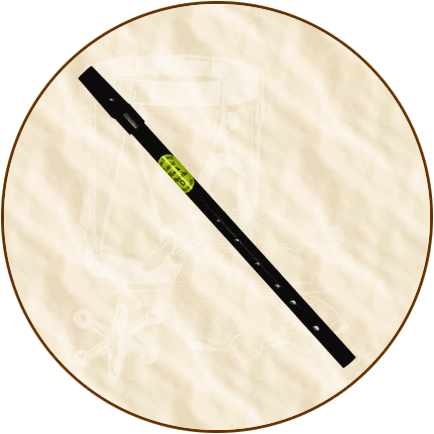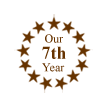.
Continued from product description on
Folk Instruments' Page Three...
Historical
Background: The whistle is a member of the family of woodwind
instruments called "fipple flutes." A fipple is a wood
block in the mouthpiece that constricts air to make sounds. Early
whistles were made from animal bones or baked clay. Early whistles
were called "vertical flutes" until the 17th century
when fipple flutes were named "flageolets." These flageolets
had four finger holes on the front and two thumb holes on the
back.
Today's tin whistle (or penny whistle) belongs to a group
of musical instruments called flageolets. (Another member is
the recorder.) The terms "whistle flutes" and "fipple
flutes" refer to the method of sound production and are
also used to designate flageolets. Again, the fipple is a wood
block or clay plug that is inserted into the mouthpiece. Sometimes
a wood whistle was carved so that the fipple was part of the
mouthpiece. The fipples found in ancient bone pipes from the
Middle Ages were made of clay.
It is the fipple that gives whistles, pipes, and flutes their
distinctive sounds. A small space is created between the edge
of the fipple and the inside wall of the instrument. When the
player blows into the mouthpiece, the fipple compresses the air
stream to make a sound. By covering (or closing) a combination
of finger and thumb holes, a musical note is produced.
Whistles are thought to have originated in ancient China around
5,000 ago. By the 11th century, whistles could be found in Europe.
There is evidence, according to medieval literature, of whistle
players in Ireland. Whistles made from the bones of birds have
been uncovered in Dublin that date back to the Viking era of
the 12th century. Over time, whistles have been given many names.
Besides fipple flute, flageolet, and vertical flute, other names
are "faedan," "feadóg stáin"
(an Irish name), "penny whistle," "tin flute,"
and "tin whistle."
To Irish musicians, this instrument has a noble pedigree in
the history of Irish music. Besides the 12-century bone whistles
found in the oldest Norman quarter of Dublin, other types of
whistle flutes are mentioned in ancient Irish tales and the laws
of ancient Irish society. One such Irish tale gives the account
of Ailen, a chief of the Tuatha de Danann fairy tribe, who carried
out his annual November vengeance by using his feadan to cast
a spell of sleep over the inhabitants of the High King's palace
at Tara. A description found in the Brehon Laws from the King
of Ireland's court in the 3rd century mentions musicians playing
feadans.
A 12th-century poem about the pre-Christian Fair of Carman
also mentions players of the "cuisle" (pipe) among
the entertainers. Despite an obvious disapproval by the poet
for the "cuisleannach" (players of the cuisle), a more
complimentary view is given by the 12th-century compiler of "Acallam
na Senorach" when comparing the cuisle's timbre to the sound
of a maiden's speech.
An interesting reference occurs in a poem found in the ancient
"Teach Miodhchuarta." This poem recounts the seating
plan of the royal feasts at Tara. Cuisleannach are seated with
the same respect and status as fishermen, jugglers, shield-makers,
shoemakers, smiths, and trumpeters (to name a few). At these
royal feasts, cuisleannach received the pig's thigh as their
allotted portion.
According to 19th-century experts on the ancient Irish society,
both the feadan (also called "feadóg") and cuisle
(also called "cuiseach") were made by hollowing out
plant stalks. Cane and elder was used as well as certain wild
grasses and reeds. Hence, another meaning for feadan is "a
hollow stick."
Medieval stone-high crosses of the 9th, 10th, and 11th centuries
suggest Irish vertical flutes to have been straight and sometimes
slightly curved at the bottom. They also had narrow, conical
bores that widened toward the bottom and are estimated to be
from 14 to 24 inches in length. (Today's manufactured tin whistles
in the key of B flat are 14-3/4 inches long.) And while this
key is pitched two whole tones below concert pitch, there is
little reliable information about the scales and pitch resources
of the feadan and cuisle. It is possible that harmonics or overblown
notes may have been used since this was usually the case with
similar flutes throughout the world.
End-blown pipes found in Somerset and Monmouthshire, England,
are thought to be representative of the general type used in
British Isles during the Medieval Period. Both these pipes were
made of deer bone and have five front finger holes. One has a
rear thumb hole and the other has two. One pipe has a range of
1-1/2 octaves and the other 2-1/2 octaves. By the way, these
pipes were restored to a playable condition, and it was found
that both pipes give diatonic scales (same as today's tin whistle).
Therefore, it is conceivable that sophisticated music could be
played on ancient bone pipes.
The tin whistles we know today have six finger holes. These
began to appear in England during the beginning of the 19th century.
The first tin whistle was made in 1843 by Robert Clark, a poor
English farm laborer and amateur musician who played a wooden
whistle. Clark wanted to copy his wooden whistle and decided
to use tinplate instead of wood. The fipple in the mouthpiece
was still made of wood, which he cut and shaped with a handmade
saw.
Clark was forced to leave his employer after having been unjustly
accused of dishonesty. In need of a way to make a living, Clark
decided to mass produce his new whistle. So, he loaded his tools
and materials into a hand barrow and walked with his son from
Suffolk to Manchester. Along the way, Clark stopped at village
markets, set up his "hand barrow workshop" to show
people how he made his whistles and sell them. When a crowd gathered
around, he would stop working and begin playing songs to entertain
the audience. Clark's most popular song was "Danny Boy,"
and it is said that an entire marketplace would stop doing business
to listen as Clark played this piece.
When he arrived in Manchester, Clark began manufacturing his
tin whistles. In the years that followed, Clark's whistles became
world famous under the name "Penny Whistle." No one
is certain just how this name came into existence. The name "penny
whistle" may have come about because Clark originally sold
his tin whistles for a penny. Then again, this name may have
been coined (excuse the pun) by Victorian street musicians who
were given pennies by passersby for playing tin whistle songs.
The company Clark started over 150 years ago, The Clark Tin Whistle
Company, continues to produce tin whistles today.
During the 1950s, a straight, cylindrical tube with a plastic
mouthpiece was introduced. This design was an alternative to
the traditional conical bore of whistles, such as the Clark tin
whistle. Twenty years later, Bernard Overton of Overton Whistles
started making the "low-D whistle." The popularity
of this whistle soon grew and remains to this day as a highly
desirable wind instrument.
Fun
Fact: The world-renowned flautist, James Galway, learned
to play music on a Clark Penny Whistle.













